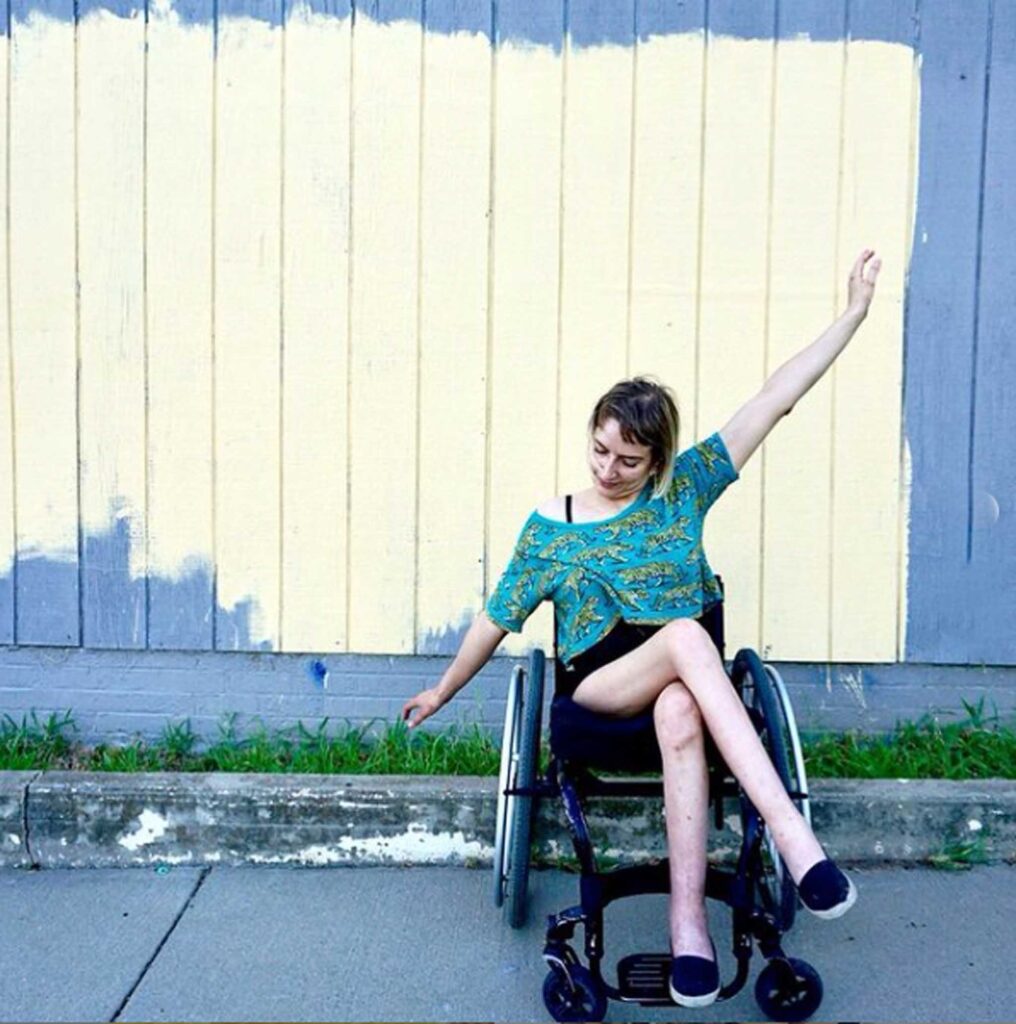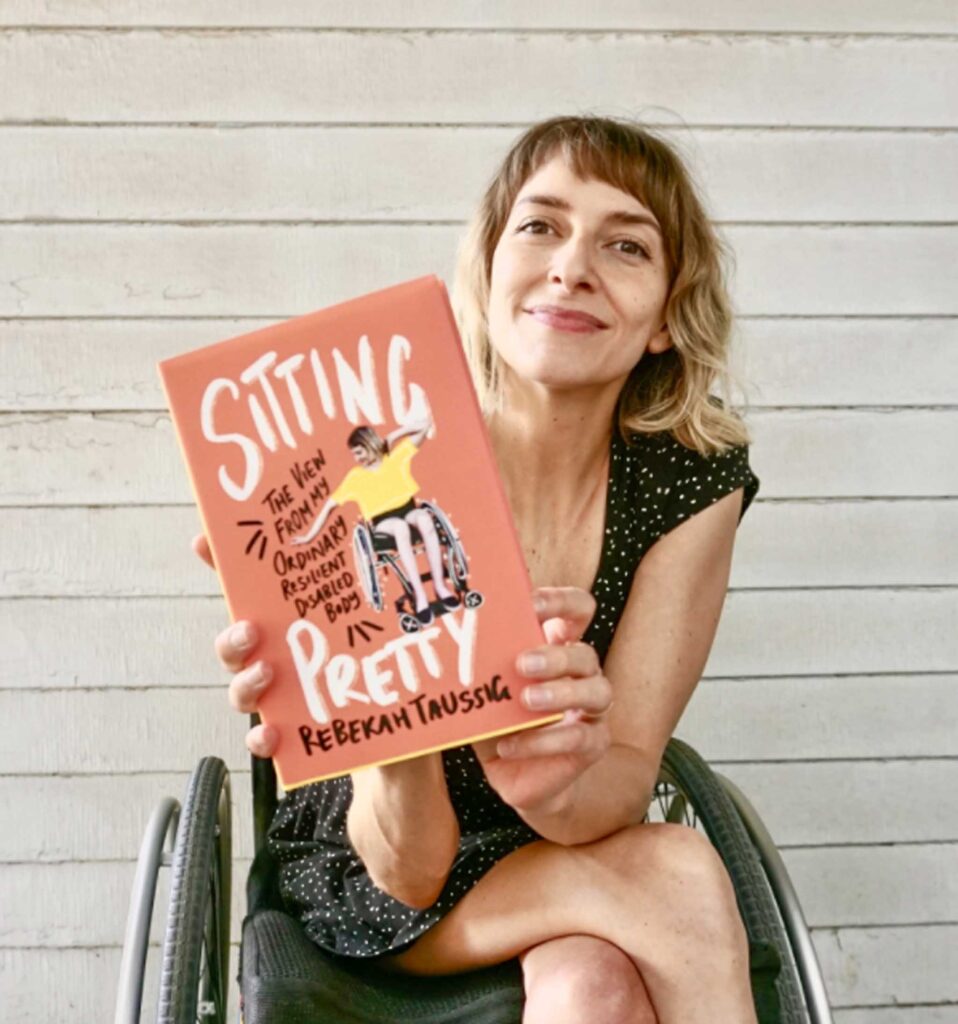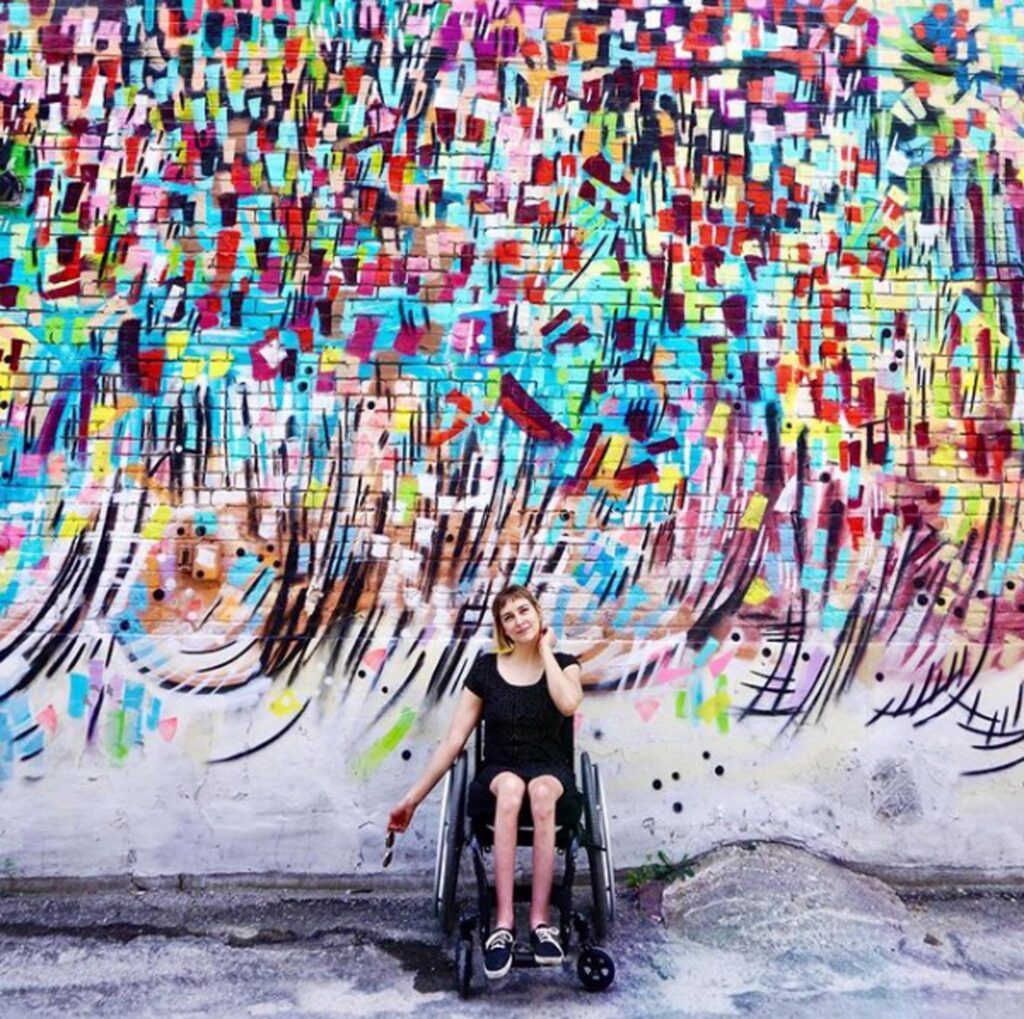”Helping and receiving help are, on the surface, obvious things. However, it is more complex and experienced differently if one goes through life with a visible disability.” From the magazine KICK 2021.

I am like a magnet for kindness. Like a black hole, my body attracts people’s good deeds from outer space down to the footrest of my wheelchair. Wherever I move—across parking lots or shopping malls, at markets or airports, in bookstores or at buffets—people rush to help me everywhere.”
On August 20, 2020, Time published an article titled Here’s why kindness toward disabled people is more complicated than you think. It was an excerpt from Rebekah Taussig’s book Sitting pretty: The view from my ordinary resilient disabled body. At the age of three, she was paralyzed as a result of cancer treatment and has used a wheelchair since first grade. Today, she lives in Kansas City and works as a teacher.
For 30 years, she has explored exactly how much she can do on her own and discovered just how helpless people generally assume she must be. ’Time and again, others have become uncomfortable or even angry when I talk about what it’s like to be the recipient of people’s kindness. This may be because many of us believe that ”kindness” is one of humanity’s most valuable qualities. Questioning our understanding of kindness is perceived as a direct threat to our self-conception and the world around us. However, as an experienced magnet for kindness, I have realized that people’s attempts to be kind can result in anything—from healing to humiliation, from genuine help to outright trauma.’

In the excerpt published in Time, Rebekah Taussig addresses a variety of common points of collision between those who function typically and those of us who are different. These situations almost always arise because of how we all, in our inherent ways, react to things that seem different/abnormal/wrong. We intervene in a situation if we judge that something needs to be done—whether it’s a car swerving down the street, a small child playing near the edge of a pier, or the smell of smoke in an apartment. Ultimately, it’s about averting threats to the survival of the species. Many people react the same way to a person in a wheelchair with an, apparently, overly large and heavy bag on their lap. They step in, believing they are saving something that would surely have gone wrong otherwise. Completely unaware of how the person in the wheelchair experiences the situation. That person may have been on the verge of completing their achievement of the year: successfully managing today’s shopping for the first time on their own. Here, the realization that things are not always as they seem is of great value.

A classic point of collision occurs when a wheelchair user is getting in or out of their car. I personally experienced this helpful incident: I had just sat down in the driver’s seat and was about to lift the wheelchair into the car. Before I had removed the first wheel, a man quickly approached.
’Wait! I’ll help you with that,’ he shouted, grabbing the wheelchair. I had been through this before. For once, I wasn’t angry; I was bursting with laughter. With a calm, adrenaline-free mind, I could choose to be pedagogical instead of judgmental. He placed the wheelchair in the trunk, closed the hatch, and happily asked if he could help me with anything else. ’Yes, you can tell me how I’m going to get the wheelchair now. I can’t walk.’
He looked completely puzzled at me. ’What do you mean?’
’When I get out of the car at home in the garage, I can’t reach the wheelchair,’ I explained. ’Not when it’s back there. That’s why I have the wheelchair here on the passenger seat.’
’Oh, I see,’ he said, lighting up. He opened the hatch, took out the wheelchair, and opened the passenger door. When he realized that he wouldn’t be able to place the wheelchair in there, he looked puzzled at me again.
’I’ll take off the wheels and fold down the backrest,’ I said.
’On the wheelchair, that is,’ I added for clarity.
’Oh, okay,’ he said, beaming again. He pulled a bit at the wheels and tugged at the backrest. The smile vanished from his face, and doubt returned.
’Don’t you know how to do it?’ I asked.
’No,’ he said, looking completely defeated.
I suggested that he place the wheelchair back where he had taken it from, and I would show him. I got the wheelchair back and continued where he had interrupted me seven minutes earlier—I folded down the backrest, lifted the back wheels onto the cargo area, removed them, placed them in the back seat, and finally lifted the frame into the passenger seat. It took hardly 30 seconds.
’Thanks for the help,’ I said as I closed the door and drove away.
Undoubtedly, the man had good intentions and wanted to help me. Hopefully, he learned something new about the concept of help: that it has at least two ends and that it’s not always obvious who is helping whom.

In the P1 program Funk this summer, the short-statured host Catrine Lundell discussed her reluctance to ask for help. She is not sure what it stems from.
’It has gone so far that I have almost injured myself to avoid asking for help,’ she says, recounting how she climbed on store shelves to reach the right type of flour.
In the program, she speaks with a psychologist, a historian, and a blind fellow host to explore where her stubbornness comes from. Is it a personal trait? Is it because she is Swedish? Or is it due to her upbringing with a congenital visible disability?
No definitive answers are reached, but together with the blind journalist Anna Bergholtz, she concludes that balance is the best way to approach one’s need for help versus the aversion to receiving it. One should manage ’just the right amount’ on their own and accept help when there is a risk of wearing oneself out.
The question is how that works in practice. For example, if you take a walk and realize it becomes too much when you are farthest from home.
’Well,’ Catrine Lundell says, laughing, ’you just have to call for transport services or a friend.’
Psychologist Anna Österåker recognizes the value of being self-sufficient and believes that it is precisely to preserve that ability that one should conserve their energy. However, a skill that isn’t maintained regularly unfortunately ceases to be a skill quite quickly. It’s not something you can keep in your pocket and pull out whenever you need it. Nor is it something that just appears, rinsed and ready to use.”
Most often, a lot of work and training lies behind the abilities that disabled individuals have acquired. For example, getting themselves and their wheelchair in and out of the car. It is something they have fought for and are proud and happy to be able to do because it opens doors to so much else. Hardly something one wants to conserve; rather the opposite. Within Active Rehabilitation, these are key concepts when it comes to motivation and engagement.
Last fall, Aftonbladet published a fairly prominent article about a young man who, four years after breaking his neck during a sports lesson, was about to lose parts of his assistance. The article exclusively focused on everything he cannot do and how dependent he is on the help of others. The journalist who wrote the piece likely did so in the belief that she was helping him. In fact, she supported the system that society offers, which forces him to focus solely on his disabilities. If he is not dependent enough on assistance, he risks losing hours of support. His only security.
From Kick Magazine 2021.


